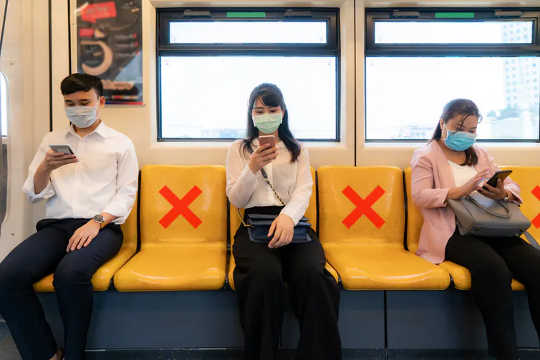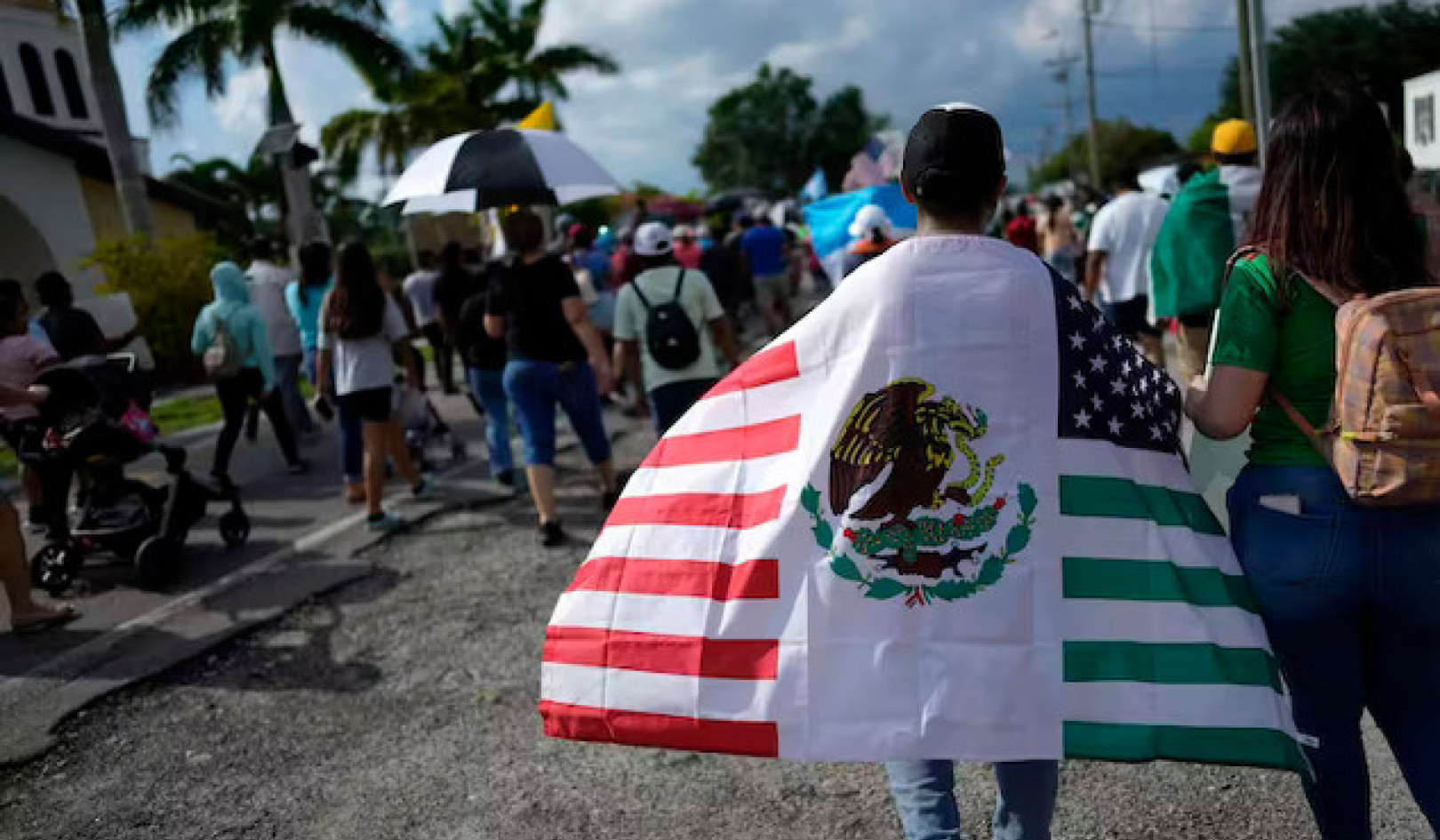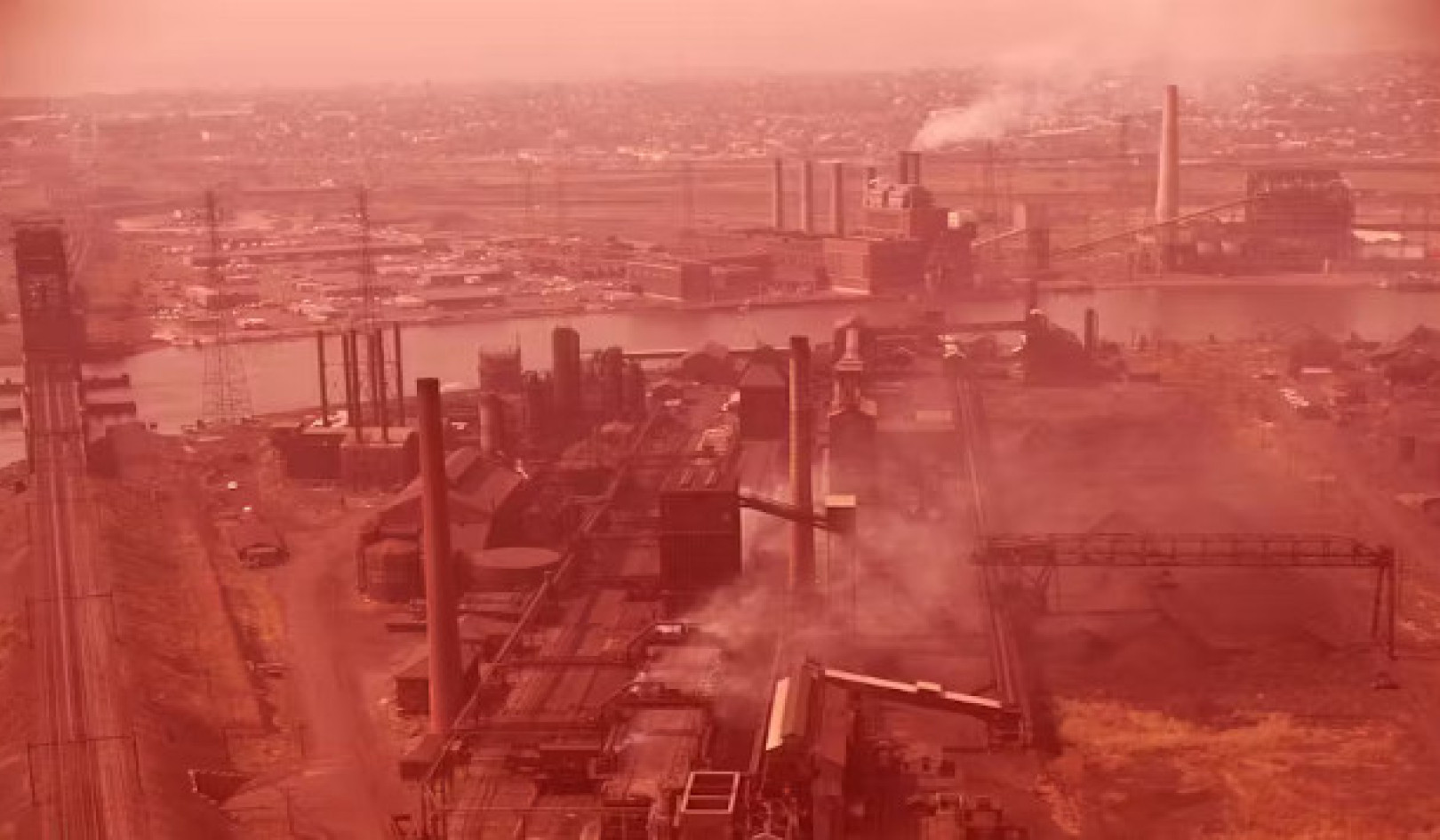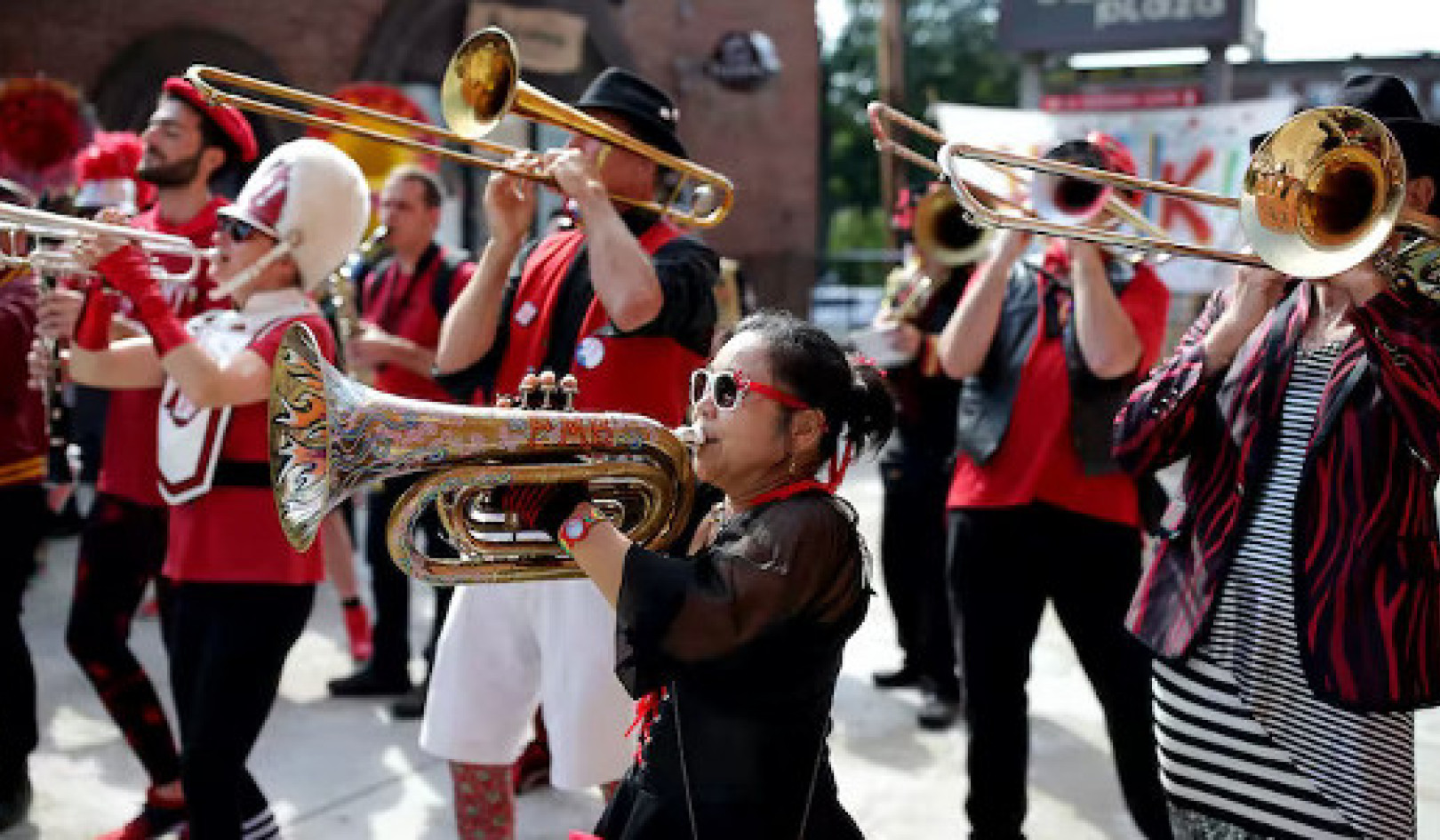During lockdown, travel restrictions caused car and public transport use to plummet across the UK. On April 12 2020, the number of daily trips by car fell to 22%, compared to a typical day the year before. Public transport use dropped too. National Rail ticket sales were at 4% of their pre-pandemic norm and bus ticket sales outside of London fell to 10%.
With one-third of the world under lockdown at one point, travel restrictions in different countries contributed to a global reduction in carbon dioxide (C0?) emissions of 17% in April, compared to 2019. But as these measures have been relaxed, personal vehicle use has increased again, approaching 80% of typical levels by mid-July. Unfortunately, public transport use remains low, with train ticket sales and buses outside of London still running at 16% and 31% of normal, respectively.
While more people opt for travel by car and private transport, the number of passengers that trains and buses can carry has also been reduced to meet social distancing guidelines. This means that people from different households must keep one to two metres apart. So, once a seat is taken, surrounding seats must be left empty.
This has had a profound effect on the climate impact of train and car travel. When running at normal capacity, public transport is more environmentally friendly than travelling by car. Although a train or bus can produce more C0? than a car, they transport far more people, so emissions per person are lower overall.
But under social distancing conditions, and assuming that any unfilled seats correspond to a commuter driving to work instead, diesel-powered public transport produces more C0? emissions per passenger than a small car.
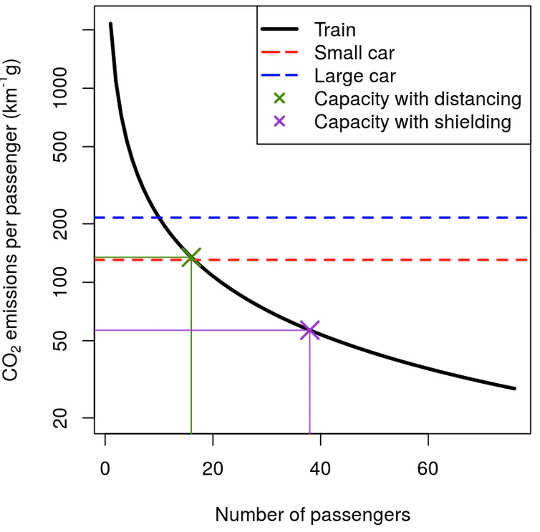
Emissions per passenger of a variety of modes of transport with a social distance of two metres. Henley, Moore and Ostler, Author provided
Keeping pandemic public transport green
So how best to pack public transport given the fixed space and social distancing guidelines? We designed an app that optimises the number, and seating arrangement, of people who can safely use public transport. The app allows a public transport company to see the optimal spacing strategy in various scenarios of social distancing and includes the option of using plastic shielding for increased isolation.
The calculation works by trying to fill in passengers from the back of the train, putting the first passenger in the first seat. The app then draws a social distancing bubble around the passenger. Other seats that are inside the bubble cannot be used, so they’re ignored and the next passenger is put in the next available seat. This process is repeated until all seats are either filled or designated as empty. This is known as a greedy algorithm – it doesn’t consider all seats at the same time, it just chooses the next available seat.
The app is currently fixed to one carriage size, and so it’s mainly useful for public transport companies making planning decisions. But it’s open-source, which means it could be extended to include different carriage designs and sizes and allow passengers to input which seats in their carriage are taken, so the app can advise which is the safest seat for them to choose.
In South Wales, the most commonly used train is the class 150 diesel engine, which was made in the 1980s. If a company using these trains can encourage at least ten passengers per carriage to use their service, then they will be more efficient than a large car. But trains using these inefficient diesel engines require a minimum of 17 passengers to be more environmentally friendly than a small car. Without the use of plastic shielding between seats though, a train carriage can only support a maximum of 16 socially distanced passengers.
Including plastic shielding in carriages can increase the maximum number of passengers in a single carriage to 38, making the emissions per passenger much lower than a small car.
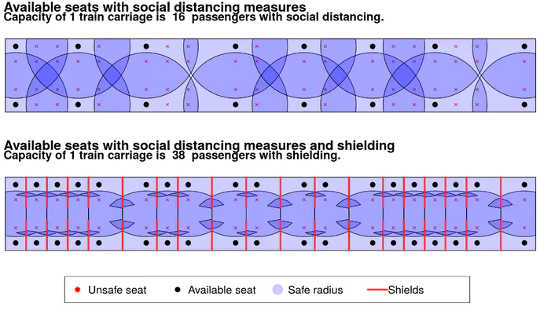
Optimal seating with plastic shielding (top) and with plastic shielding (bottom). Henley, Moore and Ostler, Author provided
Road transport makes up around 20% of the UK’s greenhouse gas emissions. Reducing this is key to the country’s strategy for meeting net zero emission targets, and public transport should play a leading role in this effort. But for that to happen, there will need to be significant changes to keep passengers safe during the pandemic while preserving the environmental benefits of bus and train travel.
Social distancing measures would either need to be reduced, while increasing other safety measures, such as mask wearing and regular cleaning, or plastic shields would need to be added between seats in train and bus carriages. Investment in lower emission engines could also help drive a transition towards more fuel-efficient public transport.
Our research should serve as a warning. As lockdown measures continue to be relaxed, more people will travel for work and leisure, increasing demand for public transport. If these services are ramped up without adding more protective measures, trains and buses could operate at a significant financial loss, while negating any benefits for the environment.![]()
About the Authors
Thomas Woolley, Lecturer in Applied Mathematics, Cardiff University; Joshua Moore, PhD Candidate in Applied Mathematics, Cardiff University; Lucy Henley, PhD Candidate in Applied Mathematics, Cardiff University, and Timothy Ostler, PhD Candidate in Applied Mathematics, Cardiff University
This article is republished from The Conversation under a Creative Commons license. Read the original article.
Related Books
Drawdown: The Most Comprehensive Plan Ever Proposed to Reverse Global Warming
by Paul Hawken and Tom Steyer In the face of widespread fear and apathy, an international coalition of researchers, professionals, and scientists have come together to offer a set of realistic and bold solutions to climate change. One hundred techniques and practices are described here—some are well known; some you may have never heard of. They range from clean energy to educating girls in lower-income countries to land use practices that pull carbon out of the air. The solutions exist, are economically viable, and communities throughout the world are currently enacting them with skill and determination. Available On Amazon
In the face of widespread fear and apathy, an international coalition of researchers, professionals, and scientists have come together to offer a set of realistic and bold solutions to climate change. One hundred techniques and practices are described here—some are well known; some you may have never heard of. They range from clean energy to educating girls in lower-income countries to land use practices that pull carbon out of the air. The solutions exist, are economically viable, and communities throughout the world are currently enacting them with skill and determination. Available On Amazon
Designing Climate Solutions: A Policy Guide for Low-Carbon Energy
by Hal Harvey, Robbie Orvis, Jeffrey Rissman With the effects of climate change already upon us, the need to cut global greenhouse gas emissions is nothing less than urgent. It’s a daunting challenge, but the technologies and strategies to meet it exist today. A small set of energy policies, designed and implemented well, can put us on the path to a low carbon future. Energy systems are large and complex, so energy policy must be focused and cost-effective. One-size-fits-all approaches simply won’t get the job done. Policymakers need a clear, comprehensive resource that outlines the energy policies that will have the biggest impact on our climate future, and describes how to design these policies well. Available On Amazon
With the effects of climate change already upon us, the need to cut global greenhouse gas emissions is nothing less than urgent. It’s a daunting challenge, but the technologies and strategies to meet it exist today. A small set of energy policies, designed and implemented well, can put us on the path to a low carbon future. Energy systems are large and complex, so energy policy must be focused and cost-effective. One-size-fits-all approaches simply won’t get the job done. Policymakers need a clear, comprehensive resource that outlines the energy policies that will have the biggest impact on our climate future, and describes how to design these policies well. Available On Amazon
This Changes Everything: Capitalism vs. The Climate
by Naomi Klein In This Changes Everything Naomi Klein argues that climate change isn’t just another issue to be neatly filed between taxes and health care. It’s an alarm that calls us to fix an economic system that is already failing us in many ways. Klein meticulously builds the case for how massively reducing our greenhouse emissions is our best chance to simultaneously reduce gaping inequalities, re-imagine our broken democracies, and rebuild our gutted local economies. She exposes the ideological desperation of the climate-change deniers, the messianic delusions of the would-be geoengineers, and the tragic defeatism of too many mainstream green initiatives. And she demonstrates precisely why the market has not—and cannot—fix the climate crisis but will instead make things worse, with ever more extreme and ecologically damaging extraction methods, accompanied by rampant disaster capitalism. Available On Amazon
In This Changes Everything Naomi Klein argues that climate change isn’t just another issue to be neatly filed between taxes and health care. It’s an alarm that calls us to fix an economic system that is already failing us in many ways. Klein meticulously builds the case for how massively reducing our greenhouse emissions is our best chance to simultaneously reduce gaping inequalities, re-imagine our broken democracies, and rebuild our gutted local economies. She exposes the ideological desperation of the climate-change deniers, the messianic delusions of the would-be geoengineers, and the tragic defeatism of too many mainstream green initiatives. And she demonstrates precisely why the market has not—and cannot—fix the climate crisis but will instead make things worse, with ever more extreme and ecologically damaging extraction methods, accompanied by rampant disaster capitalism. Available On Amazon
From The Publisher:
Purchases on Amazon go to defray the cost of bringing you InnerSelf.comelf.com, MightyNatural.com, and ClimateImpactNews.com at no cost and without advertisers that track your browsing habits. Even if you click on a link but don't buy these selected products, anything else you buy in that same visit on Amazon pays us a small commission. There is no additional cost to you, so please contribute to the effort. You can also use this link to use to Amazon at any time so you can help support our efforts.


